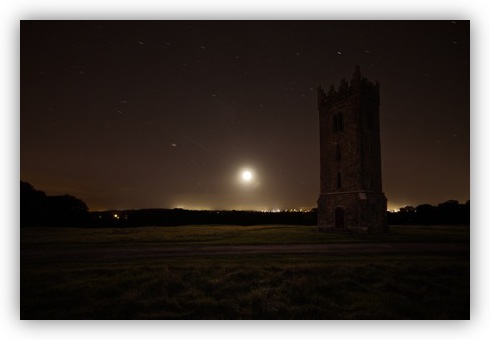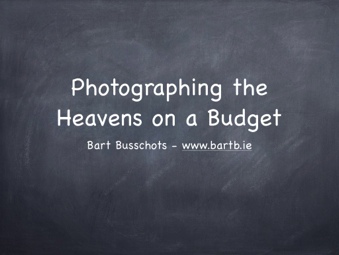Mar
27
1 iPhone, 1 Scene, 3 Lenses, 3 Photos, 3 Stories — Why Zoom Range Matters
Filed Under Photography on March 27, 2021 | Leave a Comment
I’ve spoken a lot on recent Let’s Talk Photo episodes about how my iPhone has become my primary camera, and how the ultra-wide angle lens is one of the features of the recent iPhones that excites me most. The reason why is simple — different focal lengths (zoom levels) give you different perspectives, and you can’t compensate for that by moving closer or further away from your subject. When I’m shooting artistically, zooming really isn’t about getting closer, I have feel for that — it’s about controlling the background by altering the perspective (literally).
Anyway, I was out walking this morning and came across a scene that illustrates the point nicely. I was on the grounds of St. Patrick’s College in Maynooth (well within my 5km limit and socially distancing like a responsible citizen) when I noticed that both the blue Wood Anemones and some white Daffodils were in bloom in the old apple orchard. That presented a scene with three interesting things — the two different types of flower, and the gnarly trunks of the old apple trees.
I made a point of taking the same photo with each lens to see how that changed the scene, and hence, the story the photo told. Ordinarily I would have kept the best, shared it on Twitter, and then deleted the other two, but given recent podcast episodes, I kept all three so I could use them as a practical example instead.
Jul
25
Photographing at Dusk – My Approach
Filed Under Photography on July 25, 2014 | Leave a Comment
As with everything in photography, there are an infinity of right ways of capturing that wonderful light you get just before and just after sunset. This is a description of the workflow I’ve settled on after much experimentation. It works for me, and it gives me shots with a look and feel that I like – largely realistic, but with a touch of artistic license to try capture the feel as well as the physicality of the light.
I put a lot of effort into processing my dusk shots, but, my aim is to end with a final product that doesn’t look like it’s been heavily processed. There are two reasons so much processing is needed on these kinds of shots:
- High Dynamic Range – Our eyes have a much greater dynamic range than our screens or a JPEG image can represent, and at dusk, the dynamic range is well beyond what a JPEG can represent, so what our eyes seen, and what you get straight out of a digital camera look very very different indeed.
- Mixed White Balance – Dusk scenes almost always involve mixed white balances across the scene. If you balance for the sky, the ground is usually wrong, if you balance for the ground, the sky will usually be wrong.
Shooting at dusk is all about dealing with these two problems.
Oct
18
How the Sausage is Made
Filed Under Photography on October 18, 2013 | 2 Comments
Note: This blog post formed the basis for the Chit Chat Across the Pond segment on Episode 441 of the Nosillacast Podcast.
It’s very hard to tell from a finish photograph what went into making it, so I thought it might be interesting to follow a single photo (below) all the way from idea to finished product. The photo is of the International Space Station passing in front of the Moon, and the lovely tower in the foreground is Tyrconnell Tower in Carton Estate in Ireland.
Jun
8
Photographing Satellites
Filed Under Photography, Science & Astronomy on June 8, 2013 | Leave a Comment
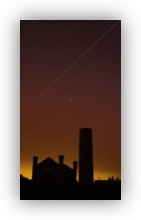 Ireland is actually quite far north, so our summer nights never get fully dark. You watch the sun set, but the glow on the horizon doesn’t go away, it slowly moves from the west through the north to the east where the sun rises again. This takes away a lot of astronomical opportunities, but, when one door closes, another opens. Because the sun never gets far below the horizon during the summer in higher northern latitudes, the part of space where satellites orbit remains in sunlight the whole night long, which means summer is satellite observing time! (The same is true in the southern hemisphere for far southern latitudes during their summer.)
Ireland is actually quite far north, so our summer nights never get fully dark. You watch the sun set, but the glow on the horizon doesn’t go away, it slowly moves from the west through the north to the east where the sun rises again. This takes away a lot of astronomical opportunities, but, when one door closes, another opens. Because the sun never gets far below the horizon during the summer in higher northern latitudes, the part of space where satellites orbit remains in sunlight the whole night long, which means summer is satellite observing time! (The same is true in the southern hemisphere for far southern latitudes during their summer.)
There are lots of ‘ordinary’ satellites which can be seen pass over each night – they look like stars that move slowly but purposefully across the sky – taking a few minutes to cross from one side of the sky to the other. These can be fun to watch, and you can photograph them with a bit of effort, but, the stars of the show are the International Space Station (ISS), which blazes across the sky shining brighter than any star, and the network of Iridium communication satellites which ‘flare’ regularly. Any satellite can ‘flare’, when the sun glints off a solar panel or communication dish, but those flares are not predictable or dependable. Iridium flares are different, because the Iridium Satellites have massive dishes pointing earthwards at all times, and as they pass over-head, the dish will come into alignment with the sun, and what starts off looking like a regular dim satellite will suddenly brighten for a few seconds and then dim again. The flare is effectively a cone that sweeps the earth, if you are in the very middle of the cone, the flare will be spectacularly bright, down to magnitude -8. For context, the magnitude scale is inverse, so the lower the number the brighter the object. The brightest stars are about magnitude 0, the brightest planets about magnitude -4, and the Moon about magnitude -11, so -8 is getting close to the brightness of the Moon!
May
5
The Royal Canal Shuttles
Filed Under Photography on May 5, 2013 | Leave a Comment
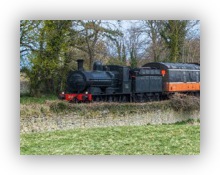 Exactly two weeks ago today (on the 21st of April 2013) the Railway Preservation Society of Ireland (RPSI) ran two steam specials from Dublin to Maynooth and back which they named Royal Canal Shuttles. The name was inspired by the fact that the section of the Sligo line between Dublin and Maynooth runs along the banks of the Royal Canal for almost its entire length.
Exactly two weeks ago today (on the 21st of April 2013) the Railway Preservation Society of Ireland (RPSI) ran two steam specials from Dublin to Maynooth and back which they named Royal Canal Shuttles. The name was inspired by the fact that the section of the Sligo line between Dublin and Maynooth runs along the banks of the Royal Canal for almost its entire length.
The trains consisted of the RPSI Cravens coaches, and were worked by the RPSI’s 0-6-0 steam loco No.186. The trains were a little more special because No.186’s boiler certificate will expire later this year, so this could well have been the last time she’ll be on this line for a decade or more. Once her certificate expires she’ll have to be fully overhauled, and given that the RPSI is a volunteer group, that will take quite some time. No.186 has proven herself to be a remarkably reliable engine over the last few years, and I’ll certainly miss seeing her around.
The weather forecast for the day was awful, but thankfully it turned out to be a little too pessimistic.
Jan
17
The 2012 RPSI Dublin Santa Specials
Filed Under Photography on January 17, 2013 | Leave a Comment
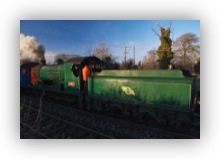 As usual, it’s taken me a while to get all my photos and videos from the Santa Special season edited and organised. Mind you, mid-January is a definite improvement over March, which is how late I was last year!
As usual, it’s taken me a while to get all my photos and videos from the Santa Special season edited and organised. Mind you, mid-January is a definite improvement over March, which is how late I was last year!
As usual, the Railway Preservation Society of Ireland (RPSI) ran two Santa Specials a day from Dublin to Maynooth to Dublin on the first three weekends of December. The trains were all scheduled to be hauled by the societies recently overhauled 2-6-0 steam loco No.461, which has been painted in the beautiful old CIE green livery. The same loco had been scheduled to run the 2011 trains too, but she was not ready on time, and all the 2011 Santa Specials from Dublin had to be hauled by diesel locos instead. Having missed the Santa Specials No.461 went on to make a decidedly unreliable return to steam over the spring and summer of 2012. Apparently No.461 took a while to bed in after her previous overhaul too, but apparently she did become very reliable over time. Hopes were high that she’d prove herself with the Santa Specials. She almost made it through the whole season, but the last two days proved too much for her, and the final three of the twelve trains had to be hauled by diesel locos.
Unfortunately my health proved to be even less reliable than No.461, and caused me to miss three out of the six days, and hence six out of the twelve trains.
Dec
29
OS X Service for Stripping Geotags from JPEG Images
Filed Under My Projects, Computers & Tech, Software Development, Photography on December 29, 2012 | 1 Comment
Back in 2011 I wrote a blog post explaining how to create an OS X Service for stripping keywords from image files. In this post we’ll use the same technique to create a Service for stripping geotags from JPEG images.
As with the keyword stripping service, there are two prerequisites for this action, one is required, one is optional. You absolutely MUST have install EXIFTool installed, and it would be good if you also had Growl installed, but it’s not essential.
Dec
22
Photographing the Heavens on a Budget
Filed Under Photography, Science & Astronomy on December 22, 2012 | 3 Comments
I recently gave a talk to Astro2, the Astronomy and Physics Society in NUI Maynooth. The talk focused on taking photos of the heavens without breaking the bank. If you set your expectations appropriately you can shoot the sky with literally any camera. You’ve not going turn your iPhone into the Hubble Space Telescope of course, but you can always get something nice, even if it’s “just” including the Moon and planets into your landscape shots.
The core idea is that you need to take as much control away from the camera’s computer as possible, so that you can push the device right up to it’s limits. To do that you need to understand how your camera works, so the talk starts with a primer on the theory of photography.
The talk is very heavily illustrated with example photos, and each example comes with a description of the settings used when shooting it.
I was asked in the talk to upload the slide deck, so I have (sorry it took so long).
Jun
17
WebifyImages.pm – My Image Editing Scripts (v0.2)
Filed Under Computers & Tech, Software Development, Photography on June 17, 2012 | 6 Comments
Yesterday I posted my thoughts on watermarking images for uploading to the web. This post formed the basis of myself and Allison Sheridan’s discussions in the Chit Chat Across the Pond segment on tonight’s Nosillacast Mac Podcast. During the discussion we talked a little about how I watermark my images, and I realised that I hadn’t released a version of my image processing scripts since 2008! I promised I’d remedy that, so today, after a little tidying up, I’m releasing the current snapshot of my scripts under the FreeBSD license.
I’m not releasing these scripts as a polished software package that’s ready to use, but rather, as a starting point for anyone who wants to create their own watermarking scripts. If you’re not prepared to get stuck into the command line and a little Perl (VERY little is needed mind), these scripts are of no use to you!
The scripts rely on the free and open source ImageMagick command line image editing tools, so you’ll need to install ImageMagick before you get stuck in. If you’re running OS X, I’d recommend installing ImageMagick via the free and open source MacPorts package manager.
Jun
16
The Big Watermarking Question
Filed Under Photography on June 16, 2012 | 3 Comments
As soon as you begin to get even slightly into photography, you’re likely to start sharing your images online, and inevitably, you’ll face the watermarking question. Do I watermark my images? Or not? If I do, how do I do it? Subtle? In your face? Somewhere in between? What ever choice you make, someone will tell you you’re wrong, and probably not politely.
One of the reasons you’ll get five opinions on watermarking from four photographers is that there is no universal right answer. Depending on why you’re publishing your work, whether you’re an amateur, pro, or something in between, what license you’re sharing your work under, and how high a resolution you’re uploading your images at, the best solution for your needs will change.
Rather than try to convince you all that the approach I’ve taken is the one everyone should take, I just want to provoke some reflection, and to help people who are just getting started arrive at a good solution for their situation. The main thing I want to do is pose some questions that I hope people will find helpful in making their own decisions. I’ll also describe the choices I’ve made, and my reasoning. My aim isn’t to share my choices as some sort of prescription, but rather as an example. And finally, I’ll end with some tips for making your watermarks subtle, if that’s the road you choose to go down.







